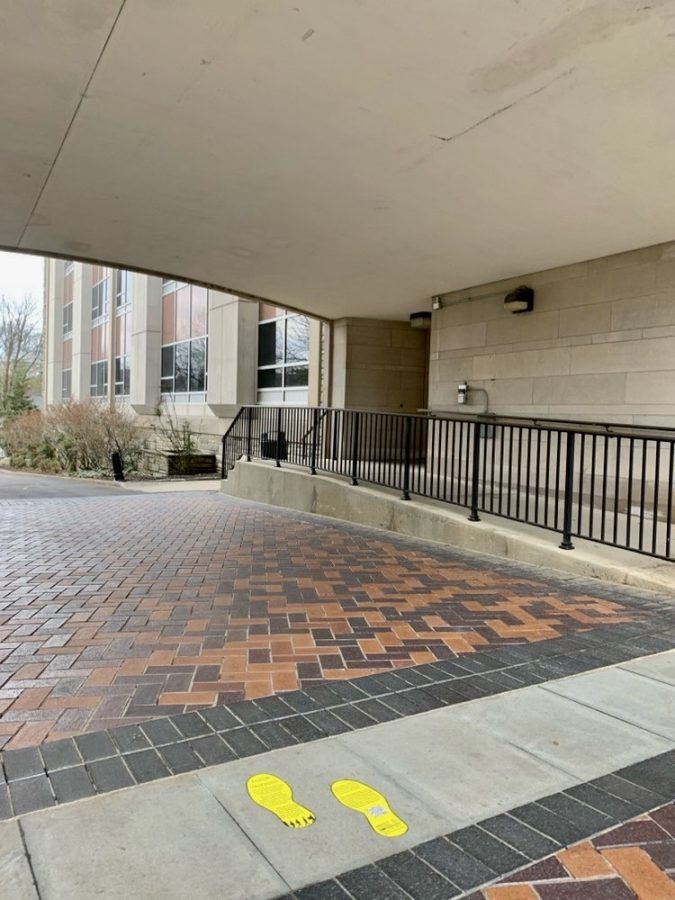University Celebrates Annual Immigration Week
Villanovan Photography/Natalia Fossas & Elizabeth Isaula-Méjia
“Footsteps of Migrants,” was a visual campaign around campus providing perspectives on the immigrant experience.
April 6, 2022
The week of Mar. 28 to Apr. 1 was Immigration Week at the University. On Monday, Mar. 28, University President Rev. Peter M. Donohue, O.S,A., Ph.D., sent an email announcing Immigration Week on campus and pointing students in the direction of the link containing the schedule of events for the week.
“The goal of the weeklong celebration is to raise awareness within the Villanova community about migrants, refugees, and asylum-seekers, as well as to provide various ways to take action and ignite change,” the email said.
According to the Immigrant Learning Center, there are approximately 44 million immigrants within the United States. This large number highlights the necessity of Immigration Week at the University and the need to bring awareness to immigration issues nationally. Also according to the Immigrant Learning Center, most immigrants in the United States are authorized, with only about 23% being undocumented, and nearly half of all immigrants in the United States have gone through the naturalization process and have become US citizens. The five largest immigrant populations in the United States come from Mexico, China, India, the Philippines and El Salvador.
University organizations Amnesty International and No Lost Generation Villanova presented Immigration Week on campus, and they were responsible for hosting and organizing many events on campus throughout the week. Amnesty International is a global movement of more than 10 million people in more than 100 countries that is dedicated to ending human rights violations worldwide. According to its Instagram page, @amnesty.nolostgen, “Amnesty International and No Lost Generation partnership at Villanova University bringing awareness to immigrant and refugee issues.”
On its Instagram page, in honor of Immigration Week, it started a series called “Myths vs. Realities Campaign: Migrant Issues.” Through this series, it addressed different issues that affect the migrant community every day of the week of Immigration Week. The posts included topics such as seeking asylum as a man versus as a woman, as well as the experiences of queer migrants. Day Two’s myth was “Queer migrants have the same experience as all other people when migrating,” while the reality was that “Queer migrants often have to travel in groups within caravans for their own protection and are more vulnerable to assault and harassment.” Be sure to check back on its Instagram, @amnesty.nolostgen, to see all of the Myth vs. Reality posts in the series to learn something new and deride myths about immigration and the experience of migrants.
Throughout the week, there was an event every day hosted by Amnesty International and No Lost Generation. On Monday, Mar. 28, the Myth vs. Realities campaign began on Instagram, and “footsteps of migrants,” a visual campaign around campus providing perspectives on the immigrant experience was held. On Tuesday, Mar. 29, an interfaith prayer vigil was held in solidarity with speakers of different faiths at the Grotto from 8 to 9 p.m. On Wednesday, an open discussion about the intersectionality of immigration was held in Driscoll 240 from 6:30 to 8 p.m.
On Thursday, Amnesty International and No Lost Generation partnered with the University’s Latin American Student Association, or LASO, for a Trivia Night with food provided in Tolentine 305 from 8:30 to 9:30 p.m.. For the last day of Immigration week, on Friday, Apr. 1, the two organizations hosted a poster making event, encouraging students to make posts advocating for immigrants to post around the University’s campus.
While this is only the third annual Immigration Week on Campus, Amnesty International and No Lost Generation came together to host and organize several events throughout the week to bring attention to the experiences of immigrants not only on campus but throughout the world. Be sure to keep an eye out for the posters created throughout Immigration Week and head to the Instagram page mentioned above to continue to learn about issues that immigrants face both on campus and globally, even after Immigration Week is over on campus.



